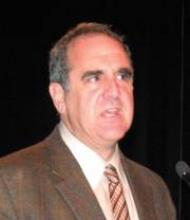SAN DIEGO – Patients with severe pain in the first 3 months after total knee replacement have worse pain and function outcomes at 1 and 2 years, and are less satisfied with the procedure, Boston researchers have found.
Because of that, severe pain after the operation "is something that we ought to be intervening on," said lead investigator Dr. Jeffrey N. Katz, professor of medicine and orthopedic surgery at Harvard Medical School, Boston.
Depressed, catastrophizing patients and those in severe pain before the operation are all at risk for severe pain afterward. Using cognitive-behavioral therapy and optimizing antidepressant dosages and pain control can help, both before and after the operation, Dr. Katz said at the World Congress on Osteoarthritis.
Also, "people might consider operating sooner," before pain becomes severe, he said.
Of the approximately 600,000 total knee replacements in the United States every year, about 15% of patients have severe pain after the operation, but until now, it wasn’t known "whether that portends poor outcomes over time," Dr. Katz said.
His team found that it did, at least in the 622 unilateral, primary, total knee replacement patients in their study. Overall, 62% were aged older than 65 years, 58% were women, 35% had a body mass index greater than 30 kg/m2; and about half had two or more comorbidities.
Their mean preoperative function score on the WOMAC (Western Ontario and McMaster Universities) osteoarthritis index was 47, and their mean preoperative WOMAC pain score was 41 (with 100 being the best score on the WOMAC index and 0 the worst possible).
Following the surgery, 15% of the patients had WOMAC pain scores lower than 50 at 3 months, which indicated severe pain. Dr. Katz and his team compared these patients with the other 85%.
The patients with severe pain at 3 months had mean WOMAC function scores of about 60 at both the 1- and 2-year follow-up. The 85% of patients without severe pain had function scores in the mid-70s at both points.
Similarly, the severe pain group had WOMAC pain scores in the mid-60s at both 1 and 2 years. The other patients had mean WOMAC scores in the mid-80s at both points.
About 60% in the severe pain group said they couldn’t walk five blocks at both 1 and 2 years. Among those without severe pain, about 40% said that couldn’t walk five blocks at both points.
Finally, about a quarter of patients in the severe pain group were dissatisfied with their surgery at both 1 and 2 years afterward. About 5% of patients without severe postsurgical pain were dissatisfied with their operation at 1 year and about 3% were dissatisfied at 2 years. All the results were statistically significant (P less than .001).
The patients came from 12 referral centers in the United States, the United Kingdom, and Australia. The study did not capture the reasons for the pain, the problems with implants (if any), or the patients’ psychiatric histories.
Dr. Katz said that the 5-year findings appear to be similar to the 1- and 2-year results, but there weren’t enough data to include them in the analysis.
The congress was sponsored by the Osteoarthritis Research Society International. The study was funded by the National Institute of Arthritis and Musculoskeletal and Skin Diseases. The data used in the analysis came from a multicenter, prospective cohort study sponsored by implant maker Stryker Corp. about a decade ago. Dr. Katz said he has no disclosures.


